Melies Part II:
Magicians in the Films of Georges Melies
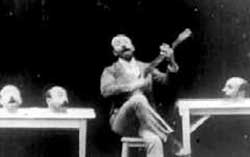 The earliest of early films were only one to three minutes long each & made every effort to make their entire point in the shortest amount of time possible. The earliest of early films were only one to three minutes long each & made every effort to make their entire point in the shortest amount of time possible.
Probably the greatest of the early pioneers was the masterful Georges Melies in France, inventing camera equipment, & testing the extreme edges of what this equipment was capable of achieving in terms of cinematic wonder.
He loved the macabre & the science fictional, which gave him every opportunity to convey on film what could never be seen on a live stage.
Less than two minutes long, in Un homme de tetes (1898) Georges Melies removes his head, puts it on a table, sprouts a new head, removes it, puts that on the table beside the other, sprouts another head to remove & place on a second table, then sits down & plays the banjo.
This tiny movie is so dark & funny, with the first "split screen" shot ever on film. It's a masterpiece of the short-short silent film in the first primitive era of cinematic art.
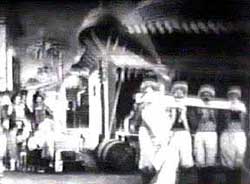 The head-removal trick also came in handy for The Terrible Turkish Executioner (Le Bourreau turc, 1904). All filmographies date this one 1904, though the date on the film itself is 1903. The head-removal trick also came in handy for The Terrible Turkish Executioner (Le Bourreau turc, 1904). All filmographies date this one 1904, though the date on the film itself is 1903.
Staged with pseudo-turkish decor, four turbaned men are placed in a long stocks, while a group of women watch. A long-bearded swordsman with enormous scimitar dances center stage with his sword whirling, & beheads all four men in a single sweep.
He then gathers up the heads & puts them in a rain barrel as the four headless men sit perfectly still shoulder to shoulder. The executioner seats himself at an outdoor table, perhaps taking care of the paperwork, & has his back to the beheaded men.
One of the heads peaks out of the rain barrel, then floats upward & reattaches itself to one of the headless men. He in turn fetches the other three heads & passes them down the line until all are restored.
The four men leap upon the executioner, take his sword, & cut his torso from his hips & legs. His legs run about the stage while the top half of his body thrashes separately. The two halves manage to get themselves put back together, with a final chase scene for closure.
Although no more macabre than many of Melies' films, there's a partially serious tone to this one that makes it ever so slightly horrific.
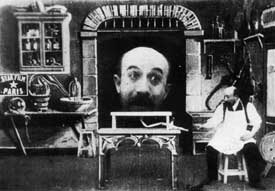 The Man with the Rubber Head (L'Homme a la tete en caoutchouc, 1901) at nearly three minutes is one of Melies' triumphs of set design, a remarkable work even before the special FX begin.
The Man with the Rubber Head (L'Homme a la tete en caoutchouc, 1901) at nearly three minutes is one of Melies' triumphs of set design, a remarkable work even before the special FX begin.
A beautifuly framed & elegant tiny film, it shows what appears to be an apothocary shopkeeper (Melies) opening his shop. He may be an alchemist, given the nature of his work.
Setting up a table, he removes from a tiny box a living head that looks exactly like his own. This he displays on the table. It's important that we can see under the table.
While the head writhes a bit, he attaches a bellows & blows it up larger & larger, then lets the air out of it. A customer comes in & wants to try the bellows, pumping up the head until it explodes.
Macabre jests dominate Melies' shortest short films & it's rather amazing that the jokes are still good ones over a century later. And the pioneer techniques to achieve the fantastic are still capable of impressing me.
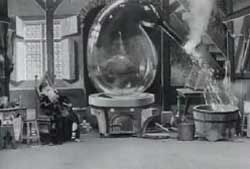 The Mysterious Retort (Alchimiste Parafaragamus ou La cornue infernale,1906) involves an alchemist working from a giant book of spells & a very large retort heated over a stove.
The Mysterious Retort (Alchimiste Parafaragamus ou La cornue infernale,1906) involves an alchemist working from a giant book of spells & a very large retort heated over a stove.
A cloth snake crawls out of the stove & turns into a sommersaulting fellow in an unusual suit, probably Mephistopheles or similar tempting imp figure. Demons & imps recur over & over again in Melies' wee films, as they give considerable leeway for magical events.
The big retort turns into a giant retort with a head then a complete human figure inside. If you compare the FX with those in The Man with the Rubber Head you'll see a striking similarity of method, mixing actual stage magic with the film tricks.
A ghostly spirit arises from a nearby wooden bucket, then the retort vanishes in a puff of smoke & knocks the alchemist unconscious (or dead) & Mephistopheles reappears victorious.
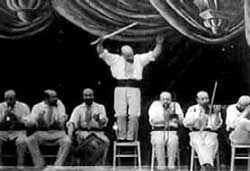 Magic acts provided perhaps Melies' most obvious theme. He provides one more minute of entertainment with An Up-to-Date Conjurer (L'Impressionniste fin de siecle, 1899). Magic acts provided perhaps Melies' most obvious theme. He provides one more minute of entertainment with An Up-to-Date Conjurer (L'Impressionniste fin de siecle, 1899).
He makes a girl vanish under a blanket, & reappear inside a tube set up on a table. He then lifts her up & she explodes into confetti.
A few more transformations & disappearances are given in rapid succession & voila, it's done.
In The One-Man Band (L'Homme ochestre, 1900) Melies again stars himself. He clones himself until he has an entire orechstra & chairs in which to seat himselves.
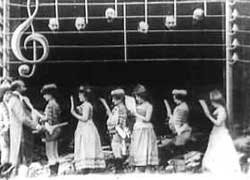 He/they give a quick performance, then he folds the extra selves back into the original, & dematerializes the chairs, adding a few vaudevilliean stunts for grand finale, all in under two minutes. He/they give a quick performance, then he folds the extra selves back into the original, & dematerializes the chairs, adding a few vaudevilliean stunts for grand finale, all in under two minutes.
It's a marvel of multiple exposures, wonderfully designed, & awfully amusing.
The Melomaniac (Le Melomane, 1903) at two & a half minutes features Melies as a band leader leading his women's marching band onto a stage.
He then begins removing his head, growing a new one, & removing that one, over & over again, placing the heads on a set of telegraph wires arranged to look like sheet music, his multiplying heads forming the notes. A couple other quick stunts, & then everyone marches off the stage. An insane very funny performance!
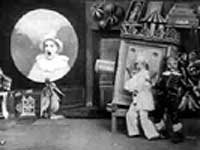 For The Magic Lantern (Le Lanterne magique, 1903), two clowns looking rather like dolls construct a huge magic-lantern (or a normal-sized one, if they are dolls) & begin to project moving pictures on the wall. For The Magic Lantern (Le Lanterne magique, 1903), two clowns looking rather like dolls construct a huge magic-lantern (or a normal-sized one, if they are dolls) & begin to project moving pictures on the wall.
They then take the magic lantern apart & lo & behjold out pops a sexy chorus line who dance about the room. Opening & closing the lantern box, more & more dancers appear, the last manifestation being a rather creepy giant puppet.
The Magic Lantern I'm betting was the first film to make what would become a common assumption in films to come, that once the lights go out at night, toys come to life.
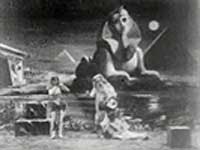 The Monster (Le Monstre, 1903) is set on the desert near the Sphinx. Two Egyptians arrive & one of them dresses up a skeleton & brings it to life. The Monster (Le Monstre, 1903) is set on the desert near the Sphinx. Two Egyptians arrive & one of them dresses up a skeleton & brings it to life.
The skeleton dances about wildly, then collapses into a heap, then rises up to dance to its master's tune again.
It is impossible to know if it is the resurged life, or the magician who made it dance, is the monster of the title.
However, according to the 1903 Lubin catalog, a different story that is obvious from the pictured event is being told, & one wonders how much the audiences of the day were told in advance to shape their viewing experience.
According to the catalog the magician is actually a mystical dervish hired by a prince to bring his beloved wife back to life. Knowing this doesn't make the monstrousness of the event less horrific; if anything, it makes it creepier, unusual for Melies whose macabre films tend to be much more whimsical than this.
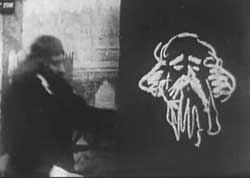 For Untamable Whiskers (Le Roi du maquillage, 1904), Melies draws a picture of himself on a chalkboard with a different hairstyle than his own, then stands waiting for his actual hair to change into the style he drew. For Untamable Whiskers (Le Roi du maquillage, 1904), Melies draws a picture of himself on a chalkboard with a different hairstyle than his own, then stands waiting for his actual hair to change into the style he drew.
He draws himself again as a scary old man with a long beard (actually it's supposed to be Shakespeare but what a lousy representation, & then transforms into just that image. Next he draws himself with an enormous mustache (perhaps audiences of the day would've recognized this as representing Admiral Nelson & again transforms before us.
Doing away with the drawings, he builds to a crescendo of excitement with rapid transformations from the bard into a clown, an admiral, a devil, then wraps himself in a blanket & disappears, all in about two minutes & a quarter.
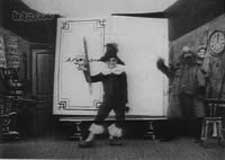 In The Magic Book (Le Libre magique, 1900), a large book is mounted on an aesel so that the audience can see it as the open pages.
In The Magic Book (Le Libre magique, 1900), a large book is mounted on an aesel so that the audience can see it as the open pages.
As the scholar turns the pages, there emerges in turn an old man, a clown, & a beautiful maiden. When the scholar attempts to woo the maiden, all the characters return to the book.
Although only a trick-film with no story to speak of, in the history of animation, Le Livre Magique is regarded one of the pivotol films in the development of stop-motion replacement of objects.
copyright © by Paghat the Ratgirl
|
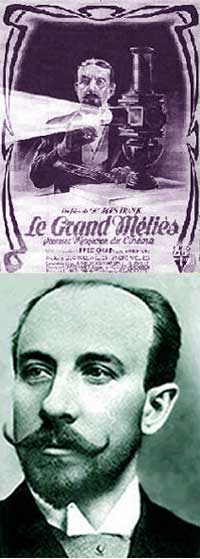





 He/they give a quick performance, then he folds the extra selves back into the original, & dematerializes the chairs, adding a few vaudevilliean stunts for grand finale, all in under two minutes.
He/they give a quick performance, then he folds the extra selves back into the original, & dematerializes the chairs, adding a few vaudevilliean stunts for grand finale, all in under two minutes.


